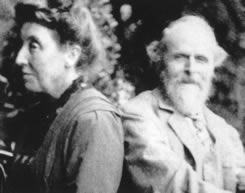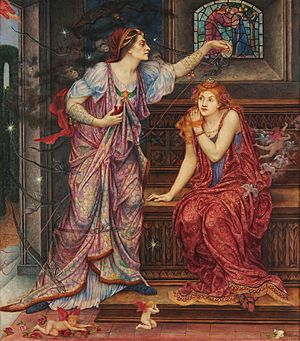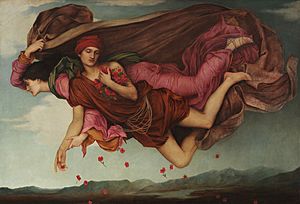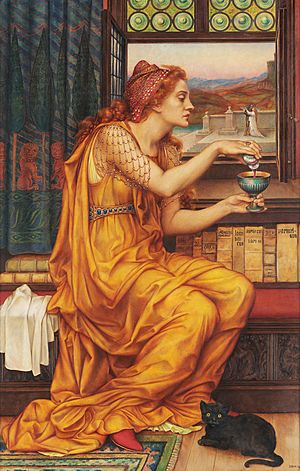Evelyn De Morgan facts for kids
Quick facts for kids
Evelyn De Morgan
|
|
|---|---|
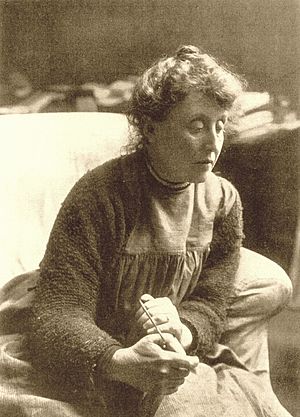
Evelyn De Morgan
|
|
| Born |
Mary Evelyn Pickering
30 August 1855 London, England
|
| Died | 2 May 1919 (aged 63) London, England
|
| Resting place | Brookwood Cemetery |
| Nationality | English |
| Education | Slade School of Art |
| Known for | painting |
|
Notable work
|
|
| Style | Pre-Raphaelite, Symbolist |
| Movement | Pre-Raphaelites |
| Spouse(s) | William De Morgan |
Evelyn De Morgan (born Mary Evelyn Pickering, 30 August 1855 – 2 May 1919) was a talented English painter. She was known for her beautiful and meaningful artworks. Early in her career, she was linked to the Pre-Raphaelite Movement, a group of artists who loved detailed and colorful art.
Evelyn's paintings often showed female figures. She used spiritual, mythological, and symbolic ideas in her art. Her works explored themes like light and darkness, change, and freedom. She also used her art to share her thoughts on important topics like spiritualism and women's rights. Later in her life, she painted about the horrors of war, showing her strong belief in peace.
Contents
Early Life and Education
Evelyn was born Mary Evelyn Pickering in London. Her father was Percival Pickering, a lawyer, and her mother was Anna Maria Wilhelmina Spencer Stanhope. Anna was the sister of another artist, John Roddam Spencer Stanhope.
Evelyn was taught at home. Her mother made sure she received the same education as her brother. She learned many languages, including Greek, Latin, French, German, and Italian. She also studied classic stories, history, and science.
When Evelyn was 15, she started drawing lessons. She was very dedicated to her art. On her 17th birthday, she wrote in her diary, "Art is eternal, but life is short… I will make up for it now, I have not a moment to lose." This shows how much she loved painting. She spent many hours working and didn't like to waste time.
Evelyn wanted to be taken seriously as an artist. She didn't want to be an "idle" woman. When her mother suggested she join high society events, Evelyn strongly refused. She wanted to focus only on her painting.
In 1872, she joined the South Kensington National Art Training School. The next year, she moved to the Slade School of Art. At Slade, she won important awards and a scholarship. She later left Slade to work more on her own.
Personal Life and Beliefs
In 1883, Evelyn met William De Morgan, who made beautiful pottery. They got married in 1887. They lived in London but spent half of every year in Florence, Italy, from 1895 until World War I began in 1914.
Evelyn De Morgan was a strong supporter of the women's right to vote. She signed a declaration in 1889 asking for women's suffrage. She also believed strongly in peace. She painted more than fifteen artworks about the horrors of World War I and the Boer War. These paintings included The Red Cross and S.O.S. In 1916, she held an exhibition of these war paintings to raise money for the Red Cross.
For many years, Evelyn used the money from her paintings to help her husband's pottery business. She even gave him ideas for his designs. They became financially secure in 1906 when William's first novel became popular.
Evelyn and William De Morgan were both spiritualists. This means they believed in communicating with spirits. This belief deeply influenced Evelyn's art. Her paintings began to show ideas about darkness, light, and the journey of the spirit. She used symbols like angels, bright glows, and strong contrasts between light and dark. She also used colors to represent spiritual ideas. Her art often told complex stories about spiritual themes, like the progress of the soul and how earthly life can trap the spirit.
Evelyn De Morgan passed away on 2 May 1919 in London. She was buried in Brookwood Cemetery, next to her husband, who had died two years earlier. Their tombstone has a special message: "Sorrow is only of the flesh / The life of the spirit is joy."
Artistic Journey
Evelyn De Morgan knew the famous artist George Frederic Watts from a young age. She often visited his studio. She also learned from her uncle, John Roddam Spencer Stanhope, who was Watts's student. Her uncle had a big impact on her painting style.
Starting in 1875, Evelyn often visited her uncle in Florence, Italy. This allowed her to study the works of great Renaissance artists like Botticelli. You can see Botticelli's influence in her paintings from this time. After this period, Evelyn's art became more unique and developed her own special style. Through her uncle, she also became friends with other Pre-Raphaelite painters like Dante Gabriel Rossetti and William Holman Hunt.
Evelyn first showed her art in 1876 at the Dudley Gallery. A year later, she exhibited at the important Grosvenor Gallery in London. She continued to show her work regularly until 1907. She even had a solo exhibition where 25 of her works were displayed. After 1907, she stopped exhibiting as often. This might have been because her husband's successful novel meant they no longer needed the money from her painting sales.
Many of Evelyn De Morgan's paintings, especially from the mid-1880s onwards, explore spiritual themes. Her later works, like Daughters of the Mist (around 1905–10), use symbolic stories to suggest deep mystical meanings rather than stating them directly.
Notable Works
Evelyn De Morgan sold her first painting, Tobias and the Angel, in August 1875. Her first painting shown in an exhibition was St Catherine of Alexandria in 1876.
Some of her most famous paintings include:
- Night and Sleep (1878)
- Aurora Triumphans (1877–1878 or c. 1886)
- Helen of Troy (1898)
- The Love Potion (1903)
- The Gilded Cage (1919)
- Flora (1894)
- The Storm Spirits (1900)
- Our Lady of Peace (1907)
- The Red Cross (1918)
Images for kids
Collections
You can find Evelyn De Morgan's artworks in several places, including:
- Walker Art Gallery in Liverpool
- National Trust properties like Wightwick Manor and Knightshayes Court
- Russell-Cotes Art Gallery and Museum
- National Portrait Gallery
- Southwark Art Collection


